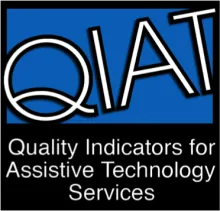Switch Progression - Assessment Guide and Useful Resources
Switch Progression - Assessment Guide and Useful Resources
This tip sheet addresses common things to consider when helping students to be effective switch users. The tip sheet discusses determining the type of switch a student needs, prompting the student for using a switch, and other considerations. Written by Ian Bean. Brought to you by our friends at SENict.
tags: Switch Access

AT Decision Making Self-Assesment
AT Decision Making Self-Assesment
This self-assessment was developed to help a team figure out how to develop or improve the AT assessment process. The AT Decision Making Self Assessment helps a team review their respective attitudes, decision-making process, and team dynamics. Using it facilitates useful discussion of underlying differences that can interfere with team function if not addressed. Brought to you by our friends at the Coalition for Assistive Technology in Oregon.
tags: Coaching for Effective AT Services, Evaluation of AT Needs

¡Oye! Puedo Yo Intentar Eso? - "Hey Can I Try That?" - Downloadable Resource (Spanish Version)
¡Oye! Puedo Yo Intentar Eso? - "Hey Can I Try That?" - Downloadable Resource (S…
Un manual para estudiantes descargable y gratuito para elegir y usar tecnología de asistencia. A free, downloadable student handbook for choosing and using assistive technology. The handbook provides scaffolds to guide a student (and their IEP team) through making decisions about assistive technology tools and services needed. Written by Gayl Bowser and Penny Reed and brought to you by our friends at the Coalition for Assistive Technology in Oregon.
tags: Spanish, Transition, Evaluation of AT Needs, AT Consideration

"Hey Can I Try That?" - Downloadable Resource (English Version)
"Hey Can I Try That?" - Downloadable Resource
A free, downloadable student handbook for choosing and using assistive technology. The handbook provides scaffolds to guide a student (and their IEP team) through making decisions about assistive technology tools and services needed. Written by Gayl Bowser and Penny Reed and brought to you by our friends at the Coalition for Assistive Technology in Oregon.
tags: Transition, Self-Determination, Evaluation of AT Needs, AT Consideration

QIAT Indicators - AT Consideration
QIAT Indicators - AT Consideration
The Quality Indicators for Assistive Technology include the specific quality indicators that were developed by focus groups and validated through research, intent statements that further explain each indicator, and a list of common errors for each of the eight areas. Consideration of the need for AT devices and services is an integral part of the educational process contained in IDEA for referral, evaluation, and IEP development. Although AT is considered at all stages of the process, the Consideration Quality Indictors are specific to the consideration of AT in the development of the IEP as mandated by the Individuals with Disabilities Education Act (IDEA). In most instances, the Quality Indicators are also appropriate for the consideration of AT for students who qualify for services under other legislation (e.g., 504, ADA).
tags: AT Consideration, Quality Indicators of Assistive Technology Services

QIAT List - A Community of Practice
QIAT List - A Community of Practice
The QIAT List is a community of practice that connects those working with individuals with disabilities and assistive technology in school settings. The QIAT List is free to join.

A Guide to Teaching Practices
Teaching strategies are practices used by adults (e.g., family members, practitioners) or, in some instances, by other children to help facilitate children’s participation in everyday routines, learning experiences, and activities. Using these strategies engages children in activities, maintains their interest, and provides opportunities for them to learn concepts and thinking skills that support STEM learning when using adaptations
tags: Inclusion, STEM, Early Childhood

A Guide to Adaptations
In this document, STEMIE defines and describes an evidence-based inclusion framework and provides definitions and examples of adaptations that adults can use to ensure young children with disabilities can participate fully in STEM learning experiences. STEMIE uses adaptations to ensure each and every child, including young children with disabilities, can fully participate and engage in STEM (science, technology, engineering, and math) learning opportunities and experiences at home, in early childhood programs, and in the community.
tags: Inclusion, STEM, Early Childhood
Eye Gaze Setup Guide
A useful poster from Call Scotland highlighting considerations and tips for setting up Eye Gaze with your learners to get the best results. It covers positioning, lighting, tracking, calibration and other important aspects of setup and is designed to be referred to by staff when setting up eye gaze with pupils on a day to day basis.
tags: AAC Evaluation, AAC

Considering Assistive Technology for Students with Disabilities
Considering Assistive Technology for Students with Disabilities
A parent-friendly checklist for IEP team members to use in determining a student's need for assistive technology.
tags: AT Consideration
